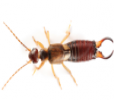
Problems with Earwigs are entirely controllable under professional care. Our treatment goal is to stop a problem at its source so it doesn’t keep coming back. Using state-of-the art equipment and methods, our licensed exterminators will inspect your home’s environment and construction to identify the problem and determine the best course of action. Contact us today!
Earwigs normally live outdoors and don’t establish themselves inside homes or buildings. They tend move rapidly around baseboards walls and ceilings. When they detect danger they will characteristically defend themselves by free-falling to the ground and scrambling to a nearby crevice. If they do enter the home, they tend to feed on sweet, oily or greasy foods or houseplants.
They are generally nocturnal, and typically hide in small, dark, moist areas in the daytime. They will inhabit small crevices, and also live in organic debris, in various forms such as bark and fallen logs. They can be responsible for serious feeding damage on flowers, vegetables, fruits and other plants, by eating the leaves. These leaves will have a ragged appearance with numerous, small, irregular holes. Aside from potential damages to crops, Earwigs are harmless to humans.
Earwigs are elongated, flattened insects, ranging from light red-brown to black. There are many species of earwigs with varying sizes, but the common European Earwig ranges from 13-20 mm (1/2 to 3/4 inch) in length. Worldwide, there’s over 2000 different species of Earwigs, and although they have wings they rarely fly. They have characteristic forceps like pincers in their abdomen (called cerci), that tend to be more curved in males than in females. These pincers are used to capture prey and defend themselves.
Earwigs are mostly scavengers, but some are omnivorous or predatory. The common earwig is one of the few insects that actively hunts for food and are omnivorous, eating arthropods, plants, and ripe fruit.
Earwigs live for about a year after hatching and develop from egg to adult through gradual metamorphosis with four to five nymphal instars or stages. During the spring or autumn, the female will lay 20 to 50 smooth, whitish, eggs in a below-ground chamber (upper two to three inches of soil).
Many earwig species display maternal care, which is uncommon especially among non-social insects. The mother will pay close attention to the needs of her eggs, such as warmth and protection. Earwigs may dig as deep as six feet below ground to escape the cold temperatures as the overwinter and wait for Spring.
Earwigs need and are very attracted to moisture. High populations of these insects may be hiding, around foundations, in landscaped yards, in mulch, under boards, bricks, and rocks. For control against insects, you will need to eliminate damp, moist conditions in crawl spaces under houses, around faucets, around air-conditioning units and along house foundations.
Make sure that rain gutters and spouts carry water away from the house foundation. Use caulking compound, foam sealants and weather stripping around doors, windows, pipes and other entry sites, especially at the ground level. Change landscaping by creating a clean, dry border immediately around the foundation wall. Gravel or ornamental stones can make an attractive barrier against earwigs and other pest invaders.